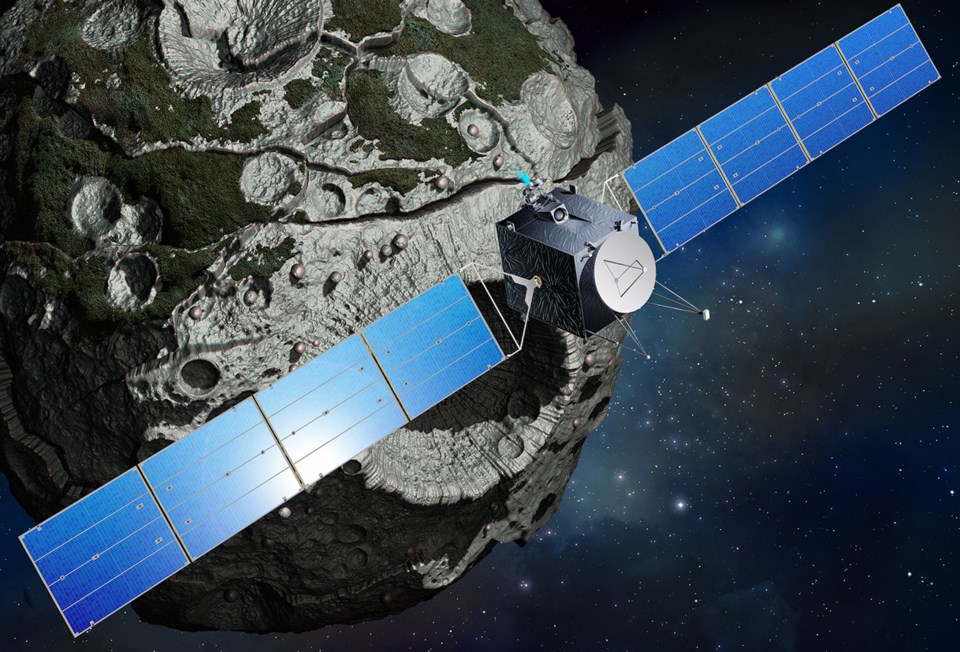A subsidiary of Richmond high-tech firm MacDonald, Dettwiler and Associates Ltd. (MDA) is helping power a space exploration mission that is worthy of a big budget, Hollywood sci-fi movie script.
Last week, the company announced that Space Systems Loral (SSL) in Palo Alto, California had been awarded a $100 million contract from NASA to provide the spacecraft intended to explore a 210 km diameter asteroid thought to be composed mostly of nickel, called 16 Psyche.
Italian astronomer Annibale de Gasparis discovered it in 1852 and named it after the Greek goddess of the soul and wife of Cupid.
After being launched from Cape Canaveral, Florida in 2023, the spacecraft’s trip to the asteroid belt, which resides roughly between the orbits of Mars and Jupiter, is expected to take about seven years to complete and cover about 179.5 million km.
So, a journey of that duration and distance required an engine that would not only be reliable, but have the efficiency to propel the telephone booth-sized main portion of the vehicle until it reaches its destination in 2030, then power it for up to another year or so as it collects data.
“These missions are selected based on the science. And the technology has to be mature and solid,” said Said Al Tadros, vice president of civil and department of defence business at SSL. “And most of the technology for this mission was existing or being developed for our commercial business.”
A small portion of that comes from MDA’s communications satellite work that is done here and in Montreal.
At the heart of the system is a solar electric propulsion system, which uses electricity gathered from solar panel arrays that extend from the body of the spacecraft.
The power it collects is used to accelerate molecules of xenon gas from an onboard tank, which serves as a propellant, to drive the 1,300 kg craft up to a speed of around 4 km per second (8,947.75 mph).
“It is not a chemical, rocket engine,” Tadros said. “It uses an electric thruster that is about five times more efficient than a chemical propulsion system, but it produces much lower thrust. So, you get a lot of efficiency for the amount of propellant, But it takes much longer to move or change direction.”
That’s an acceptable trade-off for this type of mission to such a distant destination that does not involve humans, he added.
“Humans aren’t as patient as robots,” Tadros laughed when asked if this technology could one day deliver humans to Mars.
But don’t discount it from playing a role in helping support manned flights to the red planet.
“When we are thinking about sending humans to Mars, or an asteroid, we do need to take along a lot of other equipment to prepare depots or habitats that can be shipped out before,” Tadros said. “In that way, the technology is very applicable to manned spaceflight.”
With a highly efficient engine, the unmanned, asteroid-bound spacecraft does not need as much payload room for propellant, which leaves more space for scientific equipment to study the massive chunk of what scientists believe is made up of metals.
“Scientists believe it’s an all-metal body that was once the centre of a planet in the early formation of the solar system and was decimated by an impact, or multiple impacts,” Tadros said.
The spacecraft will spend less than a year gathering data while it orbits the asteroid, and although it won’t actually make physical contact, it’s expected to learn much about it.
According to Arizona State University’s Dr. Lindy Elkins-Tanton, who is leading the exploration side of the project, the visit will be an opportunity to examine a new type of world — not one of rock or ice, but of metal.
“16 Psyche is the only known object of its kind in the solar system and this is the only way humans will ever visit a (planet) core. We learn about inner space by visiting outer space,” she said in a news release from NASA announcing the project.
Once the mission time is up, Tadros said the spacecraft is anticipated to still have enough useful life left to perhaps continue exploring the region.
“Scientists are always looking at what else they can reach once they finish collecting all the science at one destination,” Tadros said. “We’re hopeful that it will be able to conduct more science on other asteroids in that area.”



